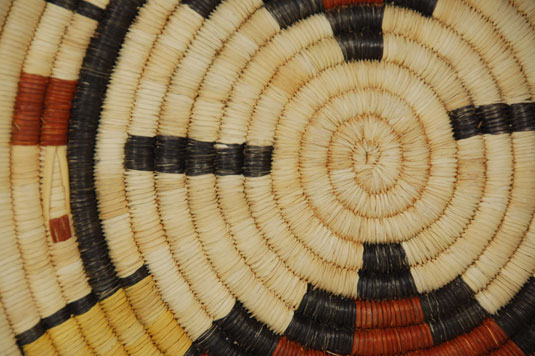Hopi 2nd Mesa Long Hair Katsina Image Plaque [SOLD]
+ Add to my watchlist Forward to Friend
- Category: Trays and Plaques
- Origin: Hopi Pueblo, Hopituh Shi-nu-mu
- Medium: galleta grass, yucca leaves
- Size: 1-1/2” deep x 13-1/8” diameter
- Item # C3736N SOLD
The coiling technique for basketry is limited to the villages of Second Mesa—Shungopavi, Shipaulovi, and Mishongnovi. It requires two sections of differing materials, placed basically at 90-degree positions. One is called the weft and the other the warp—the warp being the foundation and the weft the design or finished part. Galleta grass is used for the warp foundation and yucca leaves for the weft.
The galleta grass needs no special preparation before being used, but the yucca leaves require quite a significant amount of preparation. The yucca leaves have to be split into very thin strips, laid out to dry, bleached in the sun or dyed with native dyes. Many months of preparation are required before a basket can be started.
Hopi plaques are made year around at Second Mesa villages—some for sale and many for local use. “Thus, plaques play an important role in ‘paybacks’ for a Hopi bride’s wedding robes, and the required number seems to increase every year. Plaques are also given as gifts to repay favors or work performed by the receiver and as prizes to winners of footraces. Finally, they have symbolic meaning for newborn babies, toddlers, and small girls; they are specially made for use in kiva ceremonies and rituals; and, perhaps most of all, plaques are proudly and reverently displayed in basket dances of the women’s societies.” Teiwes 1996
As illustrated above, plaques are a major part of the social life of the Hopi. We may see them as objects made for sale but that is a minor role they play. Their chief function is for Hopi ritual. For a collector to be able to even own one of these is a treasured gift.
This plaque appears to be decorated with the face of a Long Hair Katsina, possibly. The black horizontal stripes in the center represent the eyes, the black and red rows are the chin, and the black and white alternating rows are the beard. The ears, or perhaps earrings, are imbricated, that is they are woven on top of the coil weaves. There is also imbricated weaving just below the chin.
Condition: the plaque is in excellent condition. It has a loop on the top from which it may be hung.
Recommended Reading: Hopi Basket Weaving – Artistry in Natural Fibers by Helga Teiwes. This book is currently not available from Adobe Gallery
Provenance: from a gentleman in Colorado who purchased Native craft items when he lived in Albuquerque in the 1970s and 1980s.

- Category: Trays and Plaques
- Origin: Hopi Pueblo, Hopituh Shi-nu-mu
- Medium: galleta grass, yucca leaves
- Size: 1-1/2” deep x 13-1/8” diameter
- Item # C3736N SOLD



